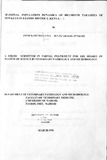| dc.description.abstract | The present study was conducted with the aim of identifying the internal parasites in
donkeys in Kiambu District of Kenya, determining their seasonal prevalence, and elucidating
the pathological lesions associated with them.
For a period of one year ( from August 1994 - August 1995), donkeys of varying ages and
sexes were examined for parasites and pathological lesions. Age and the weight of each
donkey was recorded. Fecal samples for parasite egg counts were collected once a fortnight.
In total, 353 donkeys were considered.
Six mature donkeys of mixed sexes (two, during each of the months of April, June, and
August 1995), which had not been dewormed, were purchased from the study area. They
were kept indoors and fed on hay for 14 days. They were then starved for another three days
after which they were sacrificed. A full postmortem examination was conducted on each
animal and the various portions of the gut meticulously examined for parasites . The affected
organs were identified, the gross pathological lesions recorded and tissues for histopathology
taken and processed routinely.
In the determination of the degree of infestation, it was observed that there was a statistical
significance in the difference in egg per gram counts observed between the short dry season
I and the long rain one, the long rain season and the short rain one, the long dry season and the
short rain season, the long rain season and the long dry one as well as between the various
age groups. However, there were no differences in egg counts either between the short dry
season and the short rain one or between the sexes.
Several species of helminths were identified. These were, Dictyocaulus arnfieldi which were
encountered in 100% ( 6/6 ) of the necropsied donkeys, Strongylus vulgaris, Strongylus
edentatus in 100% of the donkeys, Cylicocyclus radiatus and Strongylus equinus in 83%
and 67% respectively, Triodontophorus serratus and Cyathostomum catinutum each in 50%
of the Donkeys, Cyathostomum coronatum, Paranoplocephala mamillana, Anoplocephala
perfoliata, Gasterophilus intestinalis and Anoplocephala perfoliata each encountered in
33% of the donkeys. Habronema muscae, Triodontophorus tenuicollis, Cylicocyclus
auriculature, Cretorestom acuticalator, Trichostrongylus axei, Cylicocyclus ultrasectum,
Trichonema tetracum, and Parascaris equorum, all appeared in 17% of the necropsied
donkeys.
All the six donkeys necropsied were unthrifty and had rough hair coats and the mucous
membranes were pale. There were nodules as well as small hemorrhages throughout the wall
of the intestines and an infiltration of lymphocytes, neutrophils and eosinophils in all the
donkeys. In some cases, adult tapeworm, Anoplocephala perfoliata, were attached to the
caecal mucosa whereas other adult worms (mainly Strongylus species) were collected from
the intestines.
The lungs, in all the necropsied donkeys, were oedematous and pale and were predominantly
infiltrated with leukocytes. The ,bronchioles as well as the bronchi contained mature lung
worms (D. amifieldi), and this attracted leukocytes and an excessive ameunt of mucus.
Sections of the liver revealed Strongylus larvae surrounded by areas of necrosis and
inflammation.
In all the donkeys, the stomachs had isolated, irregular circumscribed areas varying in size
from one to several millimeters. Strongyle larvae found in the lumen of the mesenteric
arteries were firmly attached to the intima anf were associated with varying degrees of
inflammation. The only significant changes in the heart were degenerative changes in the
myocardial fibers of donkey I (sacrificed in April, 95 ). | en |

